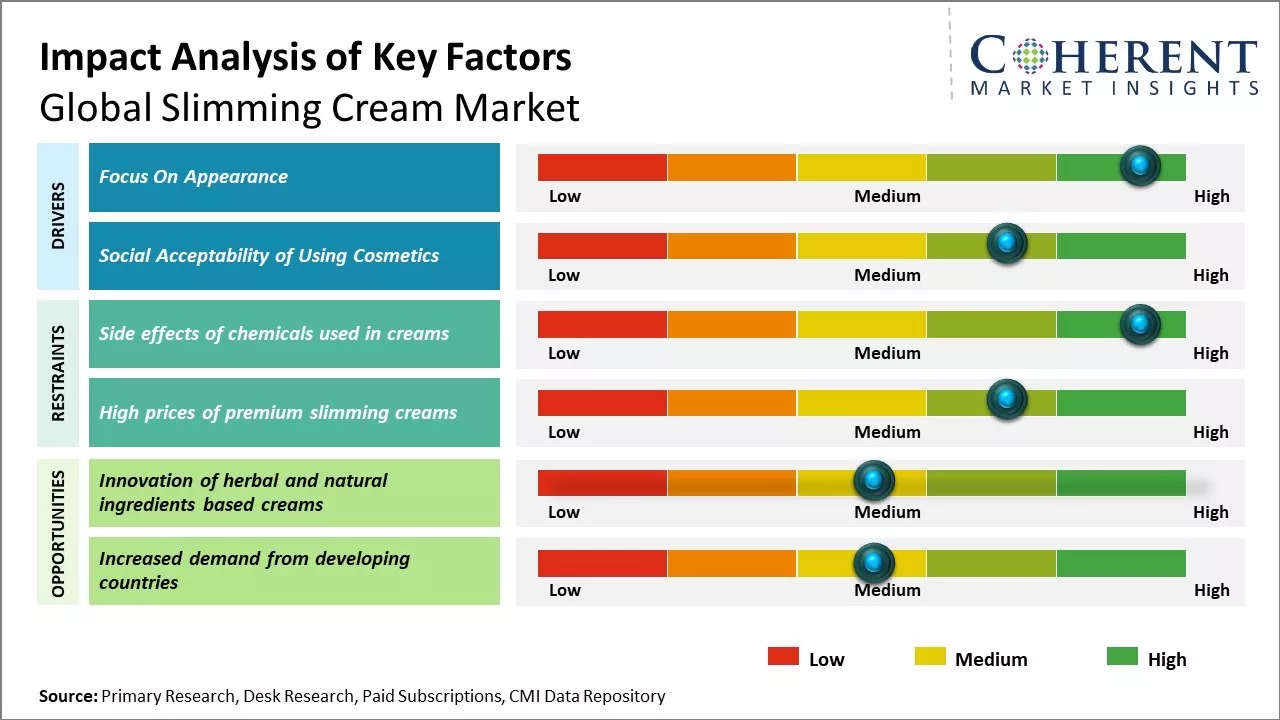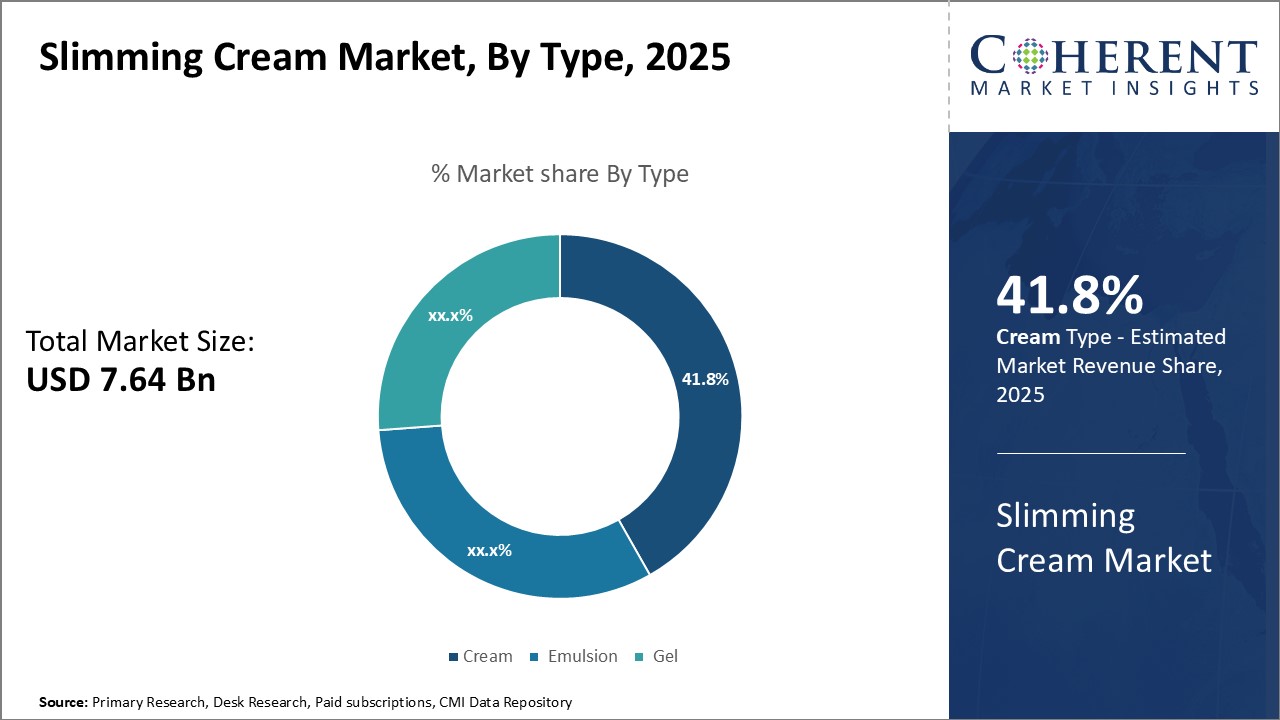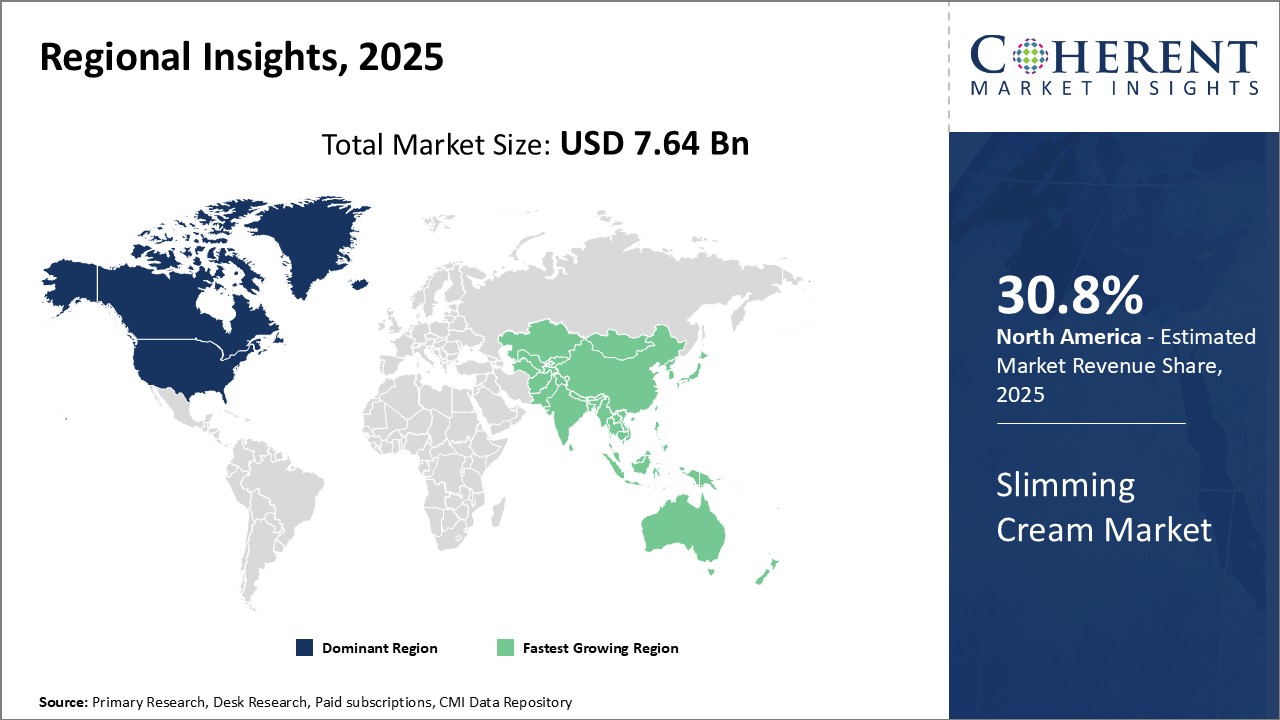The slimming cream market is estimated to be valued at USD 7.64 Bn in 2025 and is expected to reach USD 11.27 Bn by 2032, exhibiting a compound annual growth rate (CAGR) of 5.7% from 2025 to 2032.

Discover market dynamics shaping the industry: Request sample copy
The rising number of obese populations across the world and increasing focus on physical appearance is driving the demand for slimming creams globally. The slimming cream market is expected to witness a positive trend during the forecast period. With rapid urbanization and changing lifestyles, more people are getting conscious about their bodies and looks. Moreover, the increased spending capacity of consumers allows them to spend more on personal care and skin lightening products. However, strict regulations around certain ingredients used in slimming creams may hamper the market growth to some extent. New product launches incorporating natural and herbal ingredients and rising demand from emerging economies will open new avenues for players in the coming years.
Focus on Appearance
With increasing exposure to social media and popularity of picture perfect lifestyles, more and more people are becoming conscious about their appearance. There is a strong focus on having fit and slim bodies among people of all age groups. Advertisements and celebrity endorsements have created a perception that having fair and slim skin is quintessential to looking beautiful and stylish. This has made slimming and lightening creams an important beauty regime for both men and women.
People want quick fixes and easy solutions to achieve the desired body type shown in magazines and movies. Slimming creams promise visibility reduction in fat content within weeks of regular application. Manufacturers claim their products will help slim the waist, hips and thighs while also enhancing skin complexion. Even though real weight loss might not happen, a temporary reduction in circumference gives the appearance of being slimmer. Consumers are eager to try these creams for a slimmer, trimmer look without strictly, controlling their diet or exercising regularly. The growing obsession with physical appearance has increased the demand for such instant solutions and made slimming creams a multi-billion dollar industry.

Get actionable strategies to beat competition: Request sample copy
Social Acceptability of Using Cosmetics
Earlier, the use of cosmetic products like fairness creams and anti-aging creams used to be considered as a taboo and meant only for women. However, with changing social attitudes, the acceptability of using cosmetic products has increased manifold over the years cutting across gender and age barriers. People no longer hesitate to buy skin and hair care products to enhance their looks.
At the same time, the concept of beauty has broadened beyond just looking good. It is now about feeling confident and taking care of oneself. Both men and women are focusing on health, diet and personal grooming like never before. In such a scenario, using a slimming cream as part of daily skincare routine does not carry any social stigma. People openly discuss product recommendations and application tips on social media platforms without fear of judgements. Brands have also started promoting their slimming creams in a gender-neutral way to attract all potential customers. The increasing social acceptance of cosmetic products as a necessity rather than luxury is driving significant growth for the slimming cream market.
Key Takeaways from Analyst:
The increasing focus on physical appearance and fitness among consumers globally is a major driver for the market. Rising obesity levels along with growing disposable incomes especially in developing nations will spur demand.
A key restraint is the entry of cheaper private label products which are eating into the market share of established brands. Product quality and safety issues can also impact consumer confidence negatively. Furthermore, slow results achieved through the use of such creams can dissuade some consumers.
The slimming cream business provides immense opportunities for companies with new product launches addressing evolving customer preferences more effectively. However, maintaining product quality, safety and brand reputation will be critical for long term success. Also, factors like regulations, competition from other weight loss methods and economic uncertainty need careful monitoring.
Market Challenges: Side effects of chemicals used in creams
The side effects of certain chemicals used in slimming creams has become a major concern restricting the growth potential of the global market. Many slimming creams contain ingredients like laxatives, diuretics and stimulant laxatives that when used over prolonged periods can cause electrolyte imbalance in the body. Laxatives drain the body of essential minerals like potassium through excessive bowel movements. This can cause health issues like muscle cramps, weakness, irregular heartbeats etc. Stimulant laxatives on the other hand work by irritating the intestines and causing stomach cramps and diarrhoea if consumed frequently over weeks and months. These side effects have led many regulatory bodies like the European Medicines Agency to issue warnings against the chronic use of laxative-containing slimming creams.
Market Opportunities: Innovation of herbal and natural ingredients based creams
The use of natural and herbal ingredients in cosmetic products has been gaining increased popularity in recent years. Consumers are growing wary of creams containing harsh chemicals and are seeking products that contain ingredients sourced from nature. This shift towards natural and herbal formulations provides a major opportunity for innovation in the slimming cream market. Developing creams with active ingredients such as green tea, caffeine, ginger, and fragrances derived from plants can help manufacturers formulate effective products that also appeal to health-conscious consumers.

Discover high revenue pocket segments and roadmap to it: Request sample copy
Insights by Type: Widespread popularity and versatility
In terms of type, cream is expected to contribute 41.8% share of the market in 2025, owing to its widespread popularity and versatility. Cream-based slimming products dominate consumer preferences as they are lightweight, easily absorbed by the skin, and non-greasy. The cushioning texture of creams makes them comfortable to apply without feeling heavy. They hydrate the skin well while also delivering active ingredients effectively. Compared to other formats like emulsions and gels, creams are considered more gentle and suitable for all skin types.
Cream slimming products offer multi-benefit formulations that simultaneously hydrate, nourish, tone, and slim the problem areas. Popular active ingredients in cream varieties include green tea, caffeine, ginger extract, and seaweed extract that work to reduce appearance of cellulite, orange peel skin, and localized fat deposits. Their aromatic and luxurious textures appeals to consumers looking for an indulgent beauty experience along with visible results. As cream textures are easiest to apply without technical know-how, they attract first-time users and occasional buyers beyond the loyal customer base. Various size and price options allow upselling across income segments. Overall, the widespread retail availability and multi-functional aspect of cream slimming products continues driving their top share in the type segment.
Insights by Distribution Channel: Extensive product ranges and affordable pricing
In terms of distribution channel, supermarkets/hypermarkets is expected to contribute 37.1% of the market share in 2025, owing to high footfalls, extensive product ranges, and affordable pricing. As one-stop-shops for daily needs and luxury purchases alike, supermarkets have emerged as a popular destination to shop for beauty and personal care items. Their expansive shelf-space allows ample visibility for new and established slimming cream brands.
Market leaders work closely with superstores to gain premium shelf placement and run promotions that yield high volumes. Product bundling, combo offers, and lucrative discounts during seasonal festivities drive impulse purchases. Shopping malls and high streets housing these retail giants further increase catchment areas. Customers appreciate the convenience of comparing products and prices under one roof instead of visiting different specialized stores.
The self-service format along with in-store demo opportunities aid consumers in researching ingredients, textures and dermatologically-approved formulations. Supermarkets can effectively stock a diverse portfolio of local and international brands across price-points to serve varied preferences. House brand offerings provide affordable gateway options to experiment with new categories. Overall, the widespread reach and attractive value proposition cements supermarkets/hypermarkets dominance over other slimming cream distribution channels.

Need a Different Region or Segment? Customize now
The North America region has been dominating the global slimming cream market for several years. With the presence of some of the largest beauty brands, North America is expected to account for over 30.8% of the market share in 2025. Brands in countries like the U.S. and Canada have a strong foothold in the regional market owing to factors like evolving beauty standards, increased health and fitness awareness, and aggressive marketing campaigns launched by manufacturers. In addition, the higher disposable income levels and growing obesity rates have augmented the demand for slimming creams in North America.
One of the fastest growing regional markets for slimming creams is Asia Pacific. Economically progressive countries like Indonesia, Thailand, and Malaysia are witnessing a spike in the slimming cream consumption. With increasing international exposure and digital influences, beauty and appearance have become important aspects of culture and lifestyle for urban consumers in Southeast Asia. This has propelled the demand for topical fat reduction products.
Slimming Cream Market Report Coverage
| Report Coverage | Details | ||
|---|---|---|---|
| Base Year: | 2024 | Market Size in 2025: | USD 7.64 Bn |
| Historical Data for: | 2020 To 2024 | Forecast Period: | 2025 To 2032 |
| Forecast Period 2025 to 2032 CAGR: | 5.7% | 2032 Value Projection: | USD 11.27 Bn |
| Geographies covered: |
|
||
| Segments covered: |
|
||
| Companies covered: |
Clarins Cosmetics company, Mary Kay Inc, Shantou s.e.z baojie, Frank Body, L'OCCITANE India., Teamdrjoseph, and Inlife Pharma Private Limited |
||
| Growth Drivers: |
|
||
| Restraints & Challenges: |
|
||
Uncover macros and micros vetted on 75+ parameters: Get instant access to report
*Definition: Slimming cream is a topical skin care product targeted at the female weight loss market. It claims to work by penetrating the skin and activating fat cells to break down stored fat deposits. Containing ingredients like caffeine, green tea, and garcinia cambogia extracts, slimming cream promises to slim down problem areas like thighs, belly and arms through regular application. It purports to slim the body, tighten loose skin and give a toned appearance without drastic diet or exercise.
Share
Share
About Author
Yash Doshi is a Senior Management Consultant. He has 12+ years of experience in conducting research and handling consulting projects across verticals in APAC, EMEA, and the Americas.
He brings strong acumen in helping chemical companies navigate complex challenges and identify growth opportunities. He has deep expertise across the chemicals value chain, including commodity, specialty and fine chemicals, plastics and polymers, and petrochemicals. Yash is a sought-after speaker at industry conferences and contributes to various publications on topics related commodity, specialty and fine chemicals, plastics and polymers, and petrochemicals.
Missing comfort of reading report in your local language? Find your preferred language :
Transform your Strategy with Exclusive Trending Reports :
Frequently Asked Questions
Joining thousands of companies around the world committed to making the Excellent Business Solutions.
View All Our Clients
US Reciprocal Tax Impact Analysis On Slimming Cream Market
Stay updated on tariff changes with expert insights and timely information